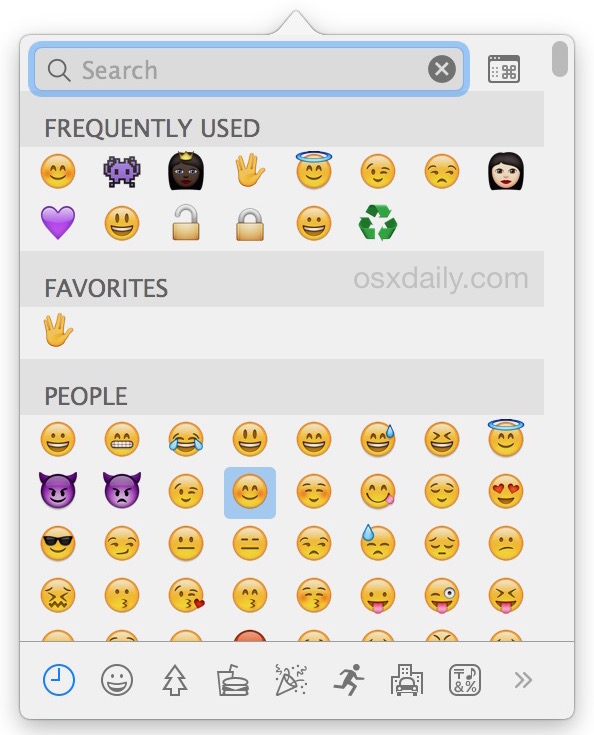Add an emoji
GO Keyboard – Emoji, Sticker For PC can be easily installed and used on a desktop computer or laptop running Windows XP, Windows 7, Windows 8, Windows 8.1, Windows 10 and a Macbook, iMac running Mac OS X. This will be done by means of an Android emulator.
- How to use emoji on Mac; How to add the emoji picker to the Menu bar; How to use emoji on Mac. Position the cursor in any text field you'd like to insert an emoji, like posting a tweet for example. Hold down the following three keys at the same time: Command+Control+Spacebar. This will bring up the emoji picker. Click the emoji you'd like to.
- Trusted Mac download Emoji Lite 2.03. Virus-free and 100% clean download. Get Emoji Lite alternative downloads.
- Included in the download: - Christmas SONGS Emoji Basic (Mac and PC) - Christmas SONGS Emoji with Scoreboard (Mac and PC w NEW PowerPoint) 📌 NOTE: The 'Auto Scoreboard' version should would great on PowerPoint for PC and newer (Office 365) PowerPoint on Macs, but unfortunately it won't work on older versions of PowerPoint for MAC.
Find the emoji keyboard in any app that uses the standard keyboard, like Mail or Messages. To add an emoji:
- Tap the text field, then tap or .
- Use the gray icons at the bottom of the keyboard to switch emoji themes, or swipe left or right to view more. Tap to see emoji that you've recently used.
- To change the skin tone of certain emoji, tap and hold an emoji.
- Tap an emoji to add it to your text field.
Tap to replace words with emoji
The Messages app shows you words that you can replace with emoji.
- Open Messages and tap to start a new message or go to an existing conversation.
- Write your message, then tap or on your keyboard.
- Wait for the words to turn orange.
- Tap an orange word to replace it with an emoji. If there's more than one emoji you can use, the Quick Reply field shows you options to choose from.
- Tap to send.
If you want to replace the emoji with the original word, just tap the emoji.
Use Predictive emoji
With Predictive text, you can write and complete entire sentences with just a tap. As you type, you see choices for words and phrases you might type next, based on your past conversations and writing style. You also see suggestions for emoji you may want to use. To use a Predictive emoji, write your message and look for the suggested emoji in the predictive input field, then tap it to replace the word or add an emoji.
To turn off Predictive text, touch and hold or , tap Keyboard Settings, then turn off Predictive.

Don't see the emoji keyboard?
If you don't see the emoji keyboard, make sure that it's turned on.

- Go to Settings > General and tap Keyboard.
- Tap Keyboards, then tap Add New Keyboard.
- Tap Emoji.
Learn more
Learn how to use Animoji to mirror your expressions or create a Memoji to match your personality or mood — all from the Messages app.
Emoji have become central to the way many of us communicate online. Whether you use them occasionally, or pepper every instant message, tweet and Instagram post with smiley faces, birthday cakes, and unicorns, they’re a great and fun way to show others what you mean or how you feel.
Using emoji on an iPhone or iPad is easy, the button is right there on the keyboard — tap it and you have immediate access to a world of faces, food, flags, and other images. On a Mac, however, there’s no obvious way to call up emoji when you want to use them. Nevertheless, they are there and using them isn’t too difficult at all. Here, we’ll show you how to get emoji on Mac, including emoji keyboard shortcuts.
How to type emoji on Mac — the character palette
- Go to the Apple menu and choose System Preferences.
- Click on the Keyboard pane and select the Input Sources tab.
- Check the box next to Show Input Sources menu in menu bar.
- Quit System Preferences.
- Click on the Input Sources menu in the menu bar and select Show Emojis & Symbols.
- When the window opens, click on Emoji and then click on the category you want.
- Scroll through the emoji or type a search term in the search bar.
- When you find the one you want, either double-click it or drag it onto the text window of the app where you want to use it.
Emoji, although rendered as images, each have a unique code, assigned by the Unicode Consortium. And, as such, they behave just like text. So, you can cut, copy, and paste emoji symbols within a document or between documents, just as you can with text.
How to use emoji on Mac — the Edit menu
In some apps, though not all, there’s an option in the Edit menu to display emoji. Here’s how to use it, using the Messages app as an example.
- In Messages, with a new message or conversation open, click on the Edit menu.
- Choose Emoji & Symbols, at the bottom of the menu.
- As above, click on Emoji and the category you want, then search or browse for the emoji symbol you want to use.
- Double-click the emoji or drag it onto the text input box in the new message or conversation.
The emoji character will now display in the message, just as it would if you were using it in the Messages app on an iPhone or iPad.
While the code for displaying Emoji characters is set by the Unicode Consortium, the look of the images themselves is chosen by the operating system developer or phone manufacturer. So, for example, the gun emoji is rendered as a handgun in Android, but as a green water pistol in macOS and iOS. And developers can add multiple skin tones to emoji for faces and hands, as Apple has done in recent versions of macOS and iOS.
Emoji keyboard shortcuts
If you’re the type of person who does everything possible to avoid reaching for the mouse or trackpad, there’s good news. You can call up the emoji window with a keyboard shortcut. Here’s how to use emoji Mac keyboard shortcuts:
- In any app that accepts text input, press Control-Command-Space.
- Use the toolbar along the bottom of the window that opens to choose a category.
- Browse or search for the emoji you want to use.
- Click the emoji to insert it at the cursor.
/article-new/2019/11/how-to-use-emoji-on-mac-2.jpg?lossy)

There’s one more way to use emoji on a Mac, if you have one of the most recent MacBook Pros with a Touch Bar. The Touch bar is connect sensitive, so its display, and the functions of its buttons change depending on what you’re doing.
If you’re typing in an app that supports emoji, Messages, for example, one of the options on the Touch Bar will be to use emoji. Sometimes tapping it will display a list of your most recently used emoji, and at others it will show emoji that are relevant to the word you’ve typed — like the iOS keyboard does.
In most apps, you can tap an emoji to call up the categories and choose one, then choose the emoji you want from there. Because Touch Bar support varies from app to app and its implementation also differs, there’s no hard and fast rules for using emoji with the Touch Bar. You’ll just have to try it out in different apps and find out how it works!
Make your Mac smile with CleanMyMac X
Emoji are a fun and effective way of communicating and using them on Mac. However, when your Mac is lagging and doesn't work as it used to, no emoji will save the situation. We advise you to use an app like CleanMyMac X.
CleanMyMac is designed to clean up, speed up, and optimize your Mac in just a few clicks. During the first scan, the average user finds about 74 GB of junk to clear out. This includes system junk, Photo junk, iTunes junk, large and old files, mail attachments, and broken downloads. With the help of CleanMyMac, you can also uninstall applications, run maintenance scripts, protect your online and offline activity, and more.
Emoji For Mac Desktop
Therefore, if you want to get the most out of your Mac and make sure it always stays as good as new, download the app (for free) and enjoy your faster Mac!